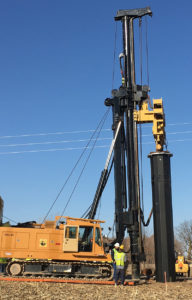Introduction
Agility, flexibility needed to plan for changing energy marketplace
Long‑term transmission planning has always been a complex undertaking, but it was relatively consistent in the days of steady load growth and a stable generation mix. But conditions in the early 21st century are no longer as predictable as they were in the past, adding new challenges to the process.
As a transmission‑only electric utility, we collaborate with our customers to determine needed replacements, expansions and connections to the grid. Recent changes in generation and the energy marketplace have required us to be flexible and agile in our planning to accommodate customer needs.
In today’s marketplace, our customers expect us to respond quickly. In fall 2017, Foxconn selected Wisconsin for its first U.S.‑based manufacturing facility for flat‑screen technology. The Mount Pleasant Tech Interconnection Project was developed to respond to the needs of a facility that would constitute the largest load at a single substation in ATC’s service territory. We filed an application in January to build a new substation and associated transmission lines with the Public Service Commission of Wisconsin, which approved the project in July. Construction will start this fall and the project will be in service in late 2019.
Upper Michigan Energy Resources Corp., a subsidiary of WEC Energy Group, proposed in early 2017 to add 180 megawatts of generation at two sites in the Upper Peninsula. The project was approved later that year, and construction began immediately. This allowed us to scale back projects identified in our Northern Area Reliability Assessment. UMERC’s two plants are located near existing transmission infrastructure and will require two new substations and only a short segment of transmission line to connect the facilities.
Generation retirements have a large impact on the transmission grid. We anticipate that more than 30 percent of the coal‑fired generation in our service territory will be retired by the end of 2019. With the retirement of the Kewaunee Nuclear Station in 2013, we canceled a pair of 50‑mile, 138‑ and 345‑kV lines that had been in the planning stages for several years – the change in generation allowed the need to be satisfied instead with a new substation that went into service this year. The announced closing of the Pleasant Prairie Power Plant in southeastern Wisconsin meant that another transmission connection into northern Illinois was no longer needed, and the Wisconsin‑Illinois Electric Reliability Project was canceled.
We also work with our customers to evaluate cost‑effective non‑transmission solutions when examining the condition of our aging assets. Recently, we made the decision to retire a 69‑kV line in northeastern Wisconsin that was in poor condition when we determined, with Wisconsin Public Service, that the local distribution company’s two substations served by the line could be tied into a nearby rebuilt 138‑kV line for about half the cost.
These examples demonstrate the dynamic nature of the electric industry today. That’s why it’s prudent to conduct an annual review of market conditions and transmission needs. Our 10‑year forecast calls for a slight decrease in capital expenditures from last year, with $2.8 to $3.4 billion in system improvements. This document contains a summary of ATC’s planning initiatives, and an overview of asset renewal and network‑driven projects in each of our planning zones.
Transmission investments
Projections from past and current Transmission System Assessments
| 2014 | 2015 | 2016 | 2017 | 2018 | |
|---|---|---|---|---|---|
| Specific Network Projects | $1.4B | $1.4B | $1.3B | $0.7B/$1.0B | $0.5B |
| Regional Multi-Value Projects | $0.5B | $0.5B | $0.5B | $0.4B | $0.3B |
| Asset Maintenance | $1.2B | $1.4B | $1.4B | $1.4B | $1.5B |
| Other Capital Categories | $0.2B/$0.8B | $0.4B/$1.2B | $0.4B/$1.2B | $0.3B/$0.8B | $0.5/$1.1B |
| Total 10-Year Capital Cost | $3.3B/$3.9B | $3.7B/$4.5B | $3.6B/$4.4B | $2.8B/$3.6B | $2.8/$3.4B |
Jim Vespalec
Director, Asset Planning & Engineering

Ron Snead
Vice President of System Planning
